
Have you ever wondered how people lit up their homes before electricity became mainstream? Well, one such ingenious invention was the kerosene lamp, also known as the paraffin lamp in some parts of the world. This traditional lighting device used kerosene as fuel and played a significant role in illuminating households.
A Reliable Source of Light
Kerosene lamps featured a wick or mantle that served as the light source. The wick, made of cotton or other materials, would soak up the kerosene fuel and produce a steady flame when ignited. The mantle, on the other hand, was a mesh-like structure that emitted a brighter and more focused light when heated by the burning kerosene.
Portability and Versatility
One of the advantages of kerosene lamps was their portability. They were not limited to being fixtures in homes; instead, they could be easily carried around. Hand-held lanterns, fueled by kerosene, offered a practical solution for portable lighting. Whether it was camping trips or outdoor activities, kerosene lamps provided a convenient source of light when electricity was not available.
A Testament to Ingenuity
The kerosene lamp was a testament to human ingenuity and resourcefulness. It brought light and warmth into countless homes, bridging the gap between dusk and dawn. These lamps not only provided essential illumination but also created a cozy and nostalgic ambiance.
So, the next time you switch on your electric lights, take a moment to appreciate the humble kerosene lamp and its historical significance. It serves as a reminder of our ability to adapt and overcome challenges.



